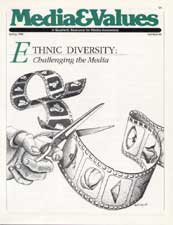Meeting Media in Every Corner of Our Lives
|
Article Images:
This article originally appeared in Issue# 57
|
One man's reflection on why media literacy is important.
I was a high school student when William Freidkin's The Exorcist found its way to theaters in my Midwest hometown. In light of what has hit the screens since, the movie's special effects and horror techniques are almost quaint; but at the time the film (and the hype surrounding it) packed quite a punch.
My friends and I became completely absorbed in the phenomena that grew up around its opening. We were fascinated by the stories that people were becoming sick in screenings. Some of us plotted to attend, somehow (since we were under the age of the R rating); others piously turned away. A friend who was an usher fed us stories of audience reactions and security precautions. For a while he was quite a celebrity by association. In my church youth group, urgent discussions of devil theology erupted, as we debated whether attendance might leave us demon-possessed.
We were possessed, all right, but not so much by Satan's conjurings as by the film producers. The Exorcist was just a movie. Nevertheless, for a while it affected every relationship I had: my friends begged me to go or not go, my parents clarified their restrictions on my recreation time, my church sisters and brothers were either titillated or scandalized, and I was expected to concur accordingly.
Here's a modern question: Is it possible to have a human relationship that is not in some way altered by the media?
Not an hour goes by in our lives that we do not speak about, refer to, or plan for the use of the media in our relationships. How do we describe the media's influence? More important than saying whether it is good or bad is recognizing that it is pervasive, like air: all around us, impossible to avoid, everywhere, all the time.
Consider that as you walk through a day of your life, you are perhaps never — not for a second— out of sight of a corporate logo or advertisement.
The first action step in becoming more media literate is to acquire an understanding of what a significant player media are in our lives. Could you chart your personal history in terms of the significant "media moments" in your life?
Not an hour goes by in our lives that we do not speak about, refer to, or plan for the use of the media in our relationships
Here are some I've collected from my own life and the lives of friends. Notice especially how these events influenced important relationships.
- In first grade, I went to bed early, before the TV show Combat came on. The next day, all the guys would play out the episode on the playground and those of us who missed it had to find something else to do.
- The mother of a teenager speaks with him about women — and he laughs. She doesn't have to tell him, he explains, the male morning disk jockey duo on the radio deals with babes every morning. "I realized I no longer have anything to say to him because someone funny got to him first," she laments.
- During the "Watergate summer" of 1974, after my junior year in high school, I watched the television coverage of the hearings, then visited Washington with friends and attended them myself. We wanted to be in the audience of what had become the hot new TV series. We were there the day the existence of the White House tapes was revealed. I felt my innocence about presidents, and about high-level politicians in general, come to a painful end.
- Women have reported that the Clarence Thomas-Anita Hill hearings, and its dramatic media coverage, will change their office relationships. "I was sexually harassed years ago," one woman said to me, "and because of Anita Hill, I would not let it go unmentioned again."
- All of us have markers for media events that were moments of mass emotion: when Kennedy was shot, when astronauts walked the moon, when our planes began bombing Iraq, the most exciting sporting event we've viewed. We tell these as though we were direct participants— even if we never meet even one of the true actors in these real-life dramas.
We all know well that media events or stories influence and illustrate our interpersonal relationships. But as you recall your own 'turning points,' you'll recognize much more than that. As in Combat's effect on playground dynamics, media can determine and create our relationships as well. Parents feel that the terms of their family life (dinner topics, vacation spots, nutritional and health decisions) are set by the media before they have a chance to raise the issues themselves. Couples and pals take for granted that part of their negotiation is choice and use of movies, TV shows, audio equipment and the sports section. None of us feel we can keep up with our reading, whether newsweeklies or catalogues or self-help digests — and we'll even shun social engagements in order to try.
We all have landmark turning points that seem to define us or set us in a new direction. How many of them are related to media?
In Bruce Beresford's film, Black Robe, several Native Canadians watch a Jesuit missionary endlessly making messy scratches onto a pad: his journal. They laugh at him because they believe this diligence to be nonsense. In order to show them what he's doing, he asks them to say a brief sentence, writes it down, and takes it to an interpreter to read aloud. As they listen to their words come back to them, they are angered that their thoughts have been stolen and captured in this way, and they conclude that the missionary must be a demon— with dire consequences for the missionary.
Like it or not, our personal lives and important relationships are redirected, sometimes radically, by the media. The question is not whether this will occur to us or not. The question is how we will perceive and handle it, how we will welcome the media or barricade ourselves against it.
Will we see the media as an Uncle Buck— overweight, embarrassing and inevitable— who barges in on our families and threatens to upend our ordered lives with crass behavior? If so, we may find ourselves victimized, counting the days until it all goes away. Of course, in the case of the media, it won't.
Or will we see the media as a foreign exchange student, a total stranger from somewhere else who comes to live with us and challenges the way we think, our habits, diet and recreation? If so, we can come away broadened in our tastes— or hardened in our stereotypes.
At best, we'll see the media as another friend: one who is worth introducing to others, one who lets us give as well as receive, one we enjoy for moments but not usually day in and day out; and, as everyone with a friend knows, one who from time to time can be completely wrong-headed.
QUESTIONING THE MEDIA
Bruce Campbell's story is a personal account of the media's role as a player in his life. The following questions can help you look at its often-unrecognized impact on your life and relationships.
- What media moments have become landmark events in your life?
- Do commercials, ads and entertainment figures "set the agenda" for you and your family by telling you what to buy, where to go, how to act?
- In what ways have news, movies and television served as models or reflections of events you've experienced?


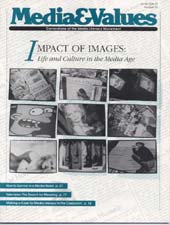


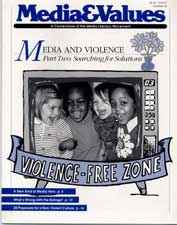
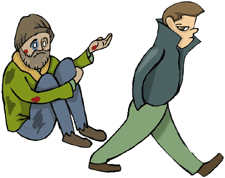 some kind of context? Don't just show us the chalk drawing of the body in the street. Give us some insight about why two street gangs are willing to go to war for the sake of a few blocks of turf. Show us how a typical police investigation works. Walk us through the criminal justice process. Bring us in on a crime victims' support group.
some kind of context? Don't just show us the chalk drawing of the body in the street. Give us some insight about why two street gangs are willing to go to war for the sake of a few blocks of turf. Show us how a typical police investigation works. Walk us through the criminal justice process. Bring us in on a crime victims' support group. 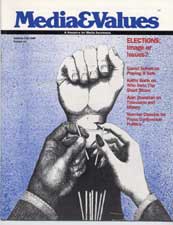
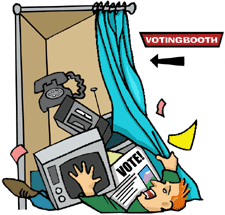 rate both before and after. In my view the low voter turnout of the last 20 years is related to the baby boom's coming of age. Its members became voters just as the voting age was lowered to I8. We thus had this huge group of newly eligible youthful voters who weren't voting because they were younger than the age at which most people tend to vote.
rate both before and after. In my view the low voter turnout of the last 20 years is related to the baby boom's coming of age. Its members became voters just as the voting age was lowered to I8. We thus had this huge group of newly eligible youthful voters who weren't voting because they were younger than the age at which most people tend to vote. 
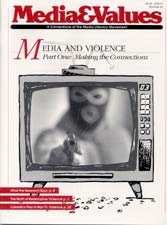
 prepared for a number of speeches I made following the April 1992 civil disturbances in south Central Los Angeles. While reviewing the events of those days, I realized that the driving force behind the rioting changed over time. In its early hours, it seemed to be driven mostly by anger and frustration — ultimately the anger and frustration of people who felt they had little chance of winning at the American Dream. But as the violence became more and more chaotic and random in its targets, it seemed driven less by doubts about participants' chances for success in gaining the American Dream than by knowing at some level that even winning would mean little, that the dream itself had become empty. This ultimate despair became a force for destruction.
prepared for a number of speeches I made following the April 1992 civil disturbances in south Central Los Angeles. While reviewing the events of those days, I realized that the driving force behind the rioting changed over time. In its early hours, it seemed to be driven mostly by anger and frustration — ultimately the anger and frustration of people who felt they had little chance of winning at the American Dream. But as the violence became more and more chaotic and random in its targets, it seemed driven less by doubts about participants' chances for success in gaining the American Dream than by knowing at some level that even winning would mean little, that the dream itself had become empty. This ultimate despair became a force for destruction. 